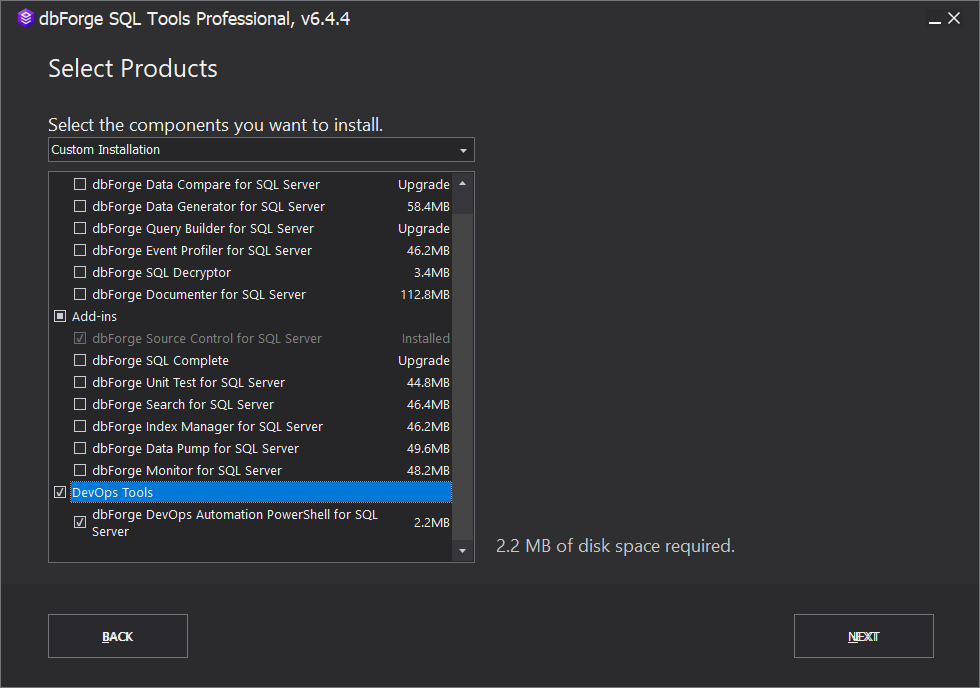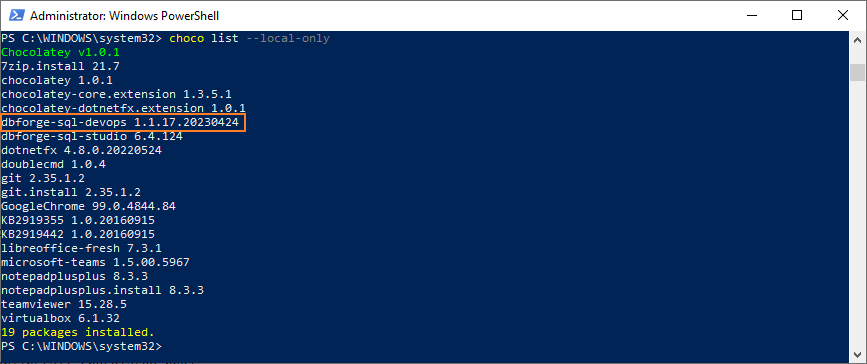How to install dbForge DevOps Automation components
Install dbForge SQL Tools
When dbForge DevOps Automation is installed on your computer, it includes executables, associated libraries, and configuration files necessary to provide its functionality.
By default, it is installed in the C:\Program Files\Devart\dbForge SQL Tools directory on your Windows system. However, during the installation process, you have the option to change the destination directory by selecting a different folder where you want to install the application.
Most Devart tools for SQL Server are available as part of the SQL Tools. You can chose which individual products to install when you run the installer.
To install SQL Tools:
-
Download the SQL Tools installer from the Devart website.
-
Run the installer, select the tools you want to install, and follow the instructions. Be aware that it may take a few minutes for all new options to appear in the SSMS/Visual Studio interface.
Note
Along with dbForge DevOps Automation PowerShell for SQL Server, you need to install at least dbForge Schema Compare for SQL Server. For a complete list of the tools you need for the full-functional work of DevOps Automation, refer to the Requirements and Compatibility topic.
Install dbForge SQL Tools via PowerShell
To install the tools via PowerShell, use the following command:
Start-Process -FilePath $installerPath -ArgumentList $arguments -Wait
-
$installerPathis a variable containing the path to the installer file -
$argumentsis a variable containing command line arguments for installing in silent mode -
Start-Processis the PowerShell command to start a process that includes the installer path and command line arguments -
Waitis the command to wait for the installation to complete
Optionally, you can include the /verysilent parameter to perform the installation without displaying any messages and without any user’s intervention.
For example, the PowerShell command could look like this:
Start-Process -FilePath "D:\sqltoolspro.exe" -ArgumentList "/verysilent" -Wait
Install PowerShell components
You can download and install dbForge DevOps Automation for SQL Server PowerShell components using the SQL Tools installer. For this, select the dbForge DevOps Automation PowerShell for SQL Server checkbox when selecting products to install in the installation wizard.

Install PowerShell components using Chocolatey
You can download and install dbForge DevOps Automation PowerShell for SQL Server using Chocolatey, which is a package manager for Windows. Before you start, ensure you have Chocolatey installed on your machine. If not, you can download it from the official website.
Once you have Chocolatey installed, you can follow these steps to install dbForge DevOps Automation PowerShell for SQL Server:
1. Open PowerShell as Administrator. For this, right-click the Windows PowerShell app, and select Run as administrator.
2. Ensure that the Get-ExecutionPolicy is not restricted. For this, run
Get-ExecutionPolicy
If it returns Restricted, then run
Set-ExecutionPolicy AllSigned
or
Set-ExecutionPolicy Bypass -Scope Process
This will allow PowerShell to run scripts for the current session.
3. Initiate the installation of dbForge DevOps Automation PowerShell for SQL Server. For this, enter the following command in the PowerShell window and press Enter:
choco install dbforge-sql-devops
4. Agree to run the script by pressing Y or A.

5. Wait for installation to complete. Chocolatey will download the dbForge DevOps Automation PowerShell for SQL Server package and install it on your computer.
6. Confirm the installation. Once the installation is complete, you can confirm it by running:
choco list --local-only
This command will list all the packages installed on your computer through Chocolatey. If the installation was successful, you should see dbforge-sql-devops in this list.

Install dbForge DevOps Automation CI plugins
Install dbForge DevOps Automation Jenkins Plugin
To install the plugin, refer to the Jenkins documentation for installation instructions. You can download the plugin using this link.
Install dbForge DevOps Automation TeamCity Plugin
To install the plugin, refer to the TeamCity documentation for installation instructions. You can download the plugin using this link.
Install dbForge DevOps Automation Azure DevOps Plugin
To install the plugin, refer to the Azure DevOps documentation for installation instructions. You can download the plugin using this link.
Install dbForge DevOps Automation Bamboo Plugin
To install the plugin, refer to the Bamboo documentation for installation instructions. You can download the plugin using this link.